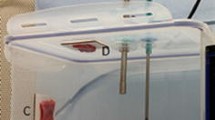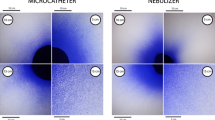Abstract
Background
Pressurized intraperitoneal aerosol chemotherapy (PIPAC) is gaining acceptance in clinical practice, but detailed information about the microinjection pump (MIP®), the generated aerosol and drug distribution is missing.
Analytical methods
Ex vivo granulometric analyses by means of laser diffraction spectrometry were performed for MIP® aerosol characterization. Beside the standard operation conditions, the impact of the volumetric liquid flow rate on the aerosol characteristics was investigated with different liquids. Granulometric results as well as the local drug distribution were verified by ex vivo gravimetric analyses. On the basis of determined MIP® characteristics, the aerosol droplet size, which is necessary for a homogenous intra-abdominal drug distribution, was calculated.
Results
Granulometric analyses showed that the MIP® aerosol consists of a bimodal volume-weighted particle size distribution (PSD3) with a median droplet diameter of x 50,3 = 25 µm. Calculations reveal that the droplet size for a homogenous intra-abdominal drug distribution during PIPAC therapy should be below 1.2 µm. We show that >97.5 vol% of the aerosolized liquid is delivered as droplets with ≥3 µm in diameter, which are primarily deposited on the surface beneath the MIP® by gravitational settling and inertial impaction. These findings were confirmed by ex vivo gravimetric analyses, where more than 86.0 vol% of the aerosolized liquid was deposited within a circular area with a diameter of 15 cm.
Conclusions
The granulometric aerosol properties, as well as the aerodynamic conditions achieved by standard MIP® operation, do not support the idea of widespread or homogenous drug distribution in the abdominal cavity.




Similar content being viewed by others
Abbreviations
- A D :
-
Cross-sectional area (m²)
- d D :
-
Diameter of nozzle orifice (m)
- h O :
-
Operation distance between MIP® outlet and target surface (m)
- IPC:
-
Intraperitoneal chemotherapy
- HELOS:
-
Helium–neon laser for optical spectrometry
- HIPEC:
-
Heated intraperitoneal chemotherapy
- LIPC:
-
Liquid intraperitoneal chemotherapy
- MIP® :
-
Microinjection pump (Reger Medizintechnik, Rottweil, Germany)
- p C :
-
Overpressure in capnoperitoneum (Pa)
- p MIP :
-
System pressure of MIP® (Pa)
- PC:
-
Peritoneal carcinomatosis
- PSD:
-
Particle size distribution
- PSD0 :
-
PSD, weighted by number
- PSD3 :
-
PSD, weighted by volume
- PIPAC:
-
Pressurized intraperitoneal aerosol chemotherapy
- q *0 :
-
Transformed distribution density, weighted by number (−)
- q 3 :
-
Distribution density, weighted by volume (1/m)
- q *3 :
-
Transformed distribution density, weighted by volume (−)
- Q 3 :
-
Cumulative distribution/function of PSD3 (−)
- Q L :
-
Volumetric liquid flow rate (L/s)
- Stk:
-
Stokes number (−)
- x :
-
Particle/droplet diameter (m)
- x 50,3 :
-
Median diameter of PSD3 (m)
- v D :
-
Droplet velocity (m/s)
References
Solass W, Hetzel A, Nadiradze G et al (2012) Description of a novel approach for intraperitoneal drug delivery and the related device. Surg Endosc 26:1849–1855
Solass W, Kerb R, Mürdter T et al (2014) Intraperitoneal chemotherapy of peritoneal carcinomatosis using pressurized aerosol as an alternative to liquid solution: first evidence for efficacy. Ann Surg Oncol 21:553–559
Jacquet P, Stuart OA, Chang D et al (1997) Effects of intra-abdominal pressure on pharmacokinetics and tissue distribution of doxorubicin after intraperitoneal administration. Anticancer Drugs 7:596–603
Solass W, Hetzel T, Schwarz T, Nadiradze G, Sagynaliev E, Reymond MA (2014) PIPAC technology. In: Reymond MA, Solass W (eds) Pressurized intraperitoneal aerosol chemotherapy—cancer under pressure, vol Chapter 8, 1st edn. De Gruyter, Berlin, pp 87–94
Khosrawipour V, Khosrawipour T, Diaz-Carballo D, Förster E, Zieren J, Giger-Pabst U (2016) Exploring the spatial drug distribution pattern during pressurized intraperitoneal aerosol chemotherapy (PIPAC). Ann Surg Oncol 23:1220–1224
Heuer M, Leschonski K (1985) Results obtained with a new instrument for the measurement of particle size distributions from diffraction patterns. Part Part Syst Charact 2:7–13
ISO 13320:2009. Particle size analysis—laser diffraction
Babick F (2016) Fraunhofer diffraction. In: Babick F (ed) Suspensions of colloidal particles and aggregates, 318th edn. Springer, Heidelberg. doi:10.1007/978-3-319-30663-6
ISO 9276-1:1998. Representation of results of particle size analysis—part 1: graphical representation
ISO 26824:2013. Particle characterization of particulate systems—vocabulary
Leschonski K (1984) Representation and evaluation of particle size analysis data. Part Part Syst Charact 1:89–95
Bowen P (2002) Particle size distribution measurement from millimeters to nanometers and from rods to platelets. J Dispers Sci Technol 23:631–662
Babick F, Ullmann C (2016) Error propagation at the conversion of particle size distribution. Powder Technol. doi:10.1016/j.powtec.2016.06.039
Göhler D, Stintz M (2014) Granulometric characterization of airborne particulate release during spray application of nanoparticle-doped coatings. J Nanopart Res 16:2520
Hinds WC (1999) Aerosol technology—properties, behavior, and measurement of airborne particles. Wiley, New York
Khilnani GC, Banga A (2004) Aerosol therapy. JIACM 5(2):114–123
Authors’ contributions
Daniel Göhler performed study design, laboratory analysis, data interpretation, drafting and critical revision for important intellectual content of the manuscript. Veria Khosrawipour carried out study design, laboratory analysis, data acquisition, drafting and critical revision for important intellectual content of the manuscript. Tanja Khosrawipour and David Diaz-Carballo were involved in drafting and critical revision for important intellectual content of the manuscript. Thomas Albert Falkenstein took part in laboratory analysis. Jürgen Zieren contributed to study design, supervision of the study, drafting and critical revision for important intellectual content of the manuscript. Michael Stintz performed data interpretation and critical revision for important intellectual content of the manuscript. Urs Giger-Pabst conducted study design, supervision of the study, laboratory analysis, data interpretation, drafting and critical revision for important intellectual content of the manuscript.
Author information
Authors and Affiliations
Corresponding author
Ethics declarations
Disclosure
This study was funded by institutional funds. Daniel Göhler, Veria Khosrawipour, Tanja Khosrawipour, David Diaz-Carballo, Thomas Albert Falkenstein, Jürgen Zieren, Michael Stintz and Urs Giger-Pabst have no conflicts of interest or financial ties to disclose.
Additional information
Daniel Göhler and Veria Khosrawipour equally contributed to the study and both should be considered as first authors.
Rights and permissions
About this article
Cite this article
Göhler, D., Khosrawipour, V., Khosrawipour, T. et al. Technical description of the microinjection pump (MIP®) and granulometric characterization of the aerosol applied for pressurized intraperitoneal aerosol chemotherapy (PIPAC). Surg Endosc 31, 1778–1784 (2017). https://doi.org/10.1007/s00464-016-5174-5
Received:
Accepted:
Published:
Issue Date:
DOI: https://doi.org/10.1007/s00464-016-5174-5




